Table of Contents
What is Stratified cuboidal epithelium?
- Stratified cuboidal epithelium is a specialized type of epithelial tissue characterized by its multi-layered cellular structure. The most distinctive feature of this epithelium is the cuboidal shape of the cells present in its apical layer.
- Beneath this layer, the cells may adopt either a cuboidal or columnar morphology. The cellular composition of the deeper layers can differ from the apical layer, and these variations are often influenced by the specific location and role of the epithelial tissue within the body.
- Epithelial tissues, in general, serve as linings for body cavities and surfaces. Their primary functions include protection, selective absorption, and secretion. Stratified cuboidal epithelium, in particular, predominantly resides in glandular structures. These glands are adept at selective absorption and secretion into blood or lymphatic vessels.
- The term “stratified” denotes the presence of multiple layers of cells, while “cuboidal” describes the cube-like shape of the cells on the tissue’s surface. Beneath these cuboidal cells, layers of squamous epithelial cells can be found, which play a crucial role in replenishing the epithelial lining when damage occurs.
- One of the primary roles of stratified cuboidal epithelium is to provide a barrier between the functional cells of an organ or gland and the vessels that nourish it.
- While this epithelium can be observed in various tissues throughout the body, its fundamental structure and function remain consistent. However, subtle differences might arise based on the specific roles of the organs in which they are found.
- In summary, stratified cuboidal epithelium is a multi-layered epithelial tissue with a distinctive cellular structure. Its presence in glandular tissues underscores its importance in processes like absorption and secretion, ensuring the proper functioning of various organs and systems within the body.
Definition of Stratified cuboidal epithelium
Stratified cuboidal epithelium is a type of epithelial tissue characterized by multiple layers of cells, with the surface layer consisting of cube-shaped cells. It is primarily found in glandular structures and plays roles in protection, selective absorption, and secretion.
Stratified cuboidal epithelium labeled
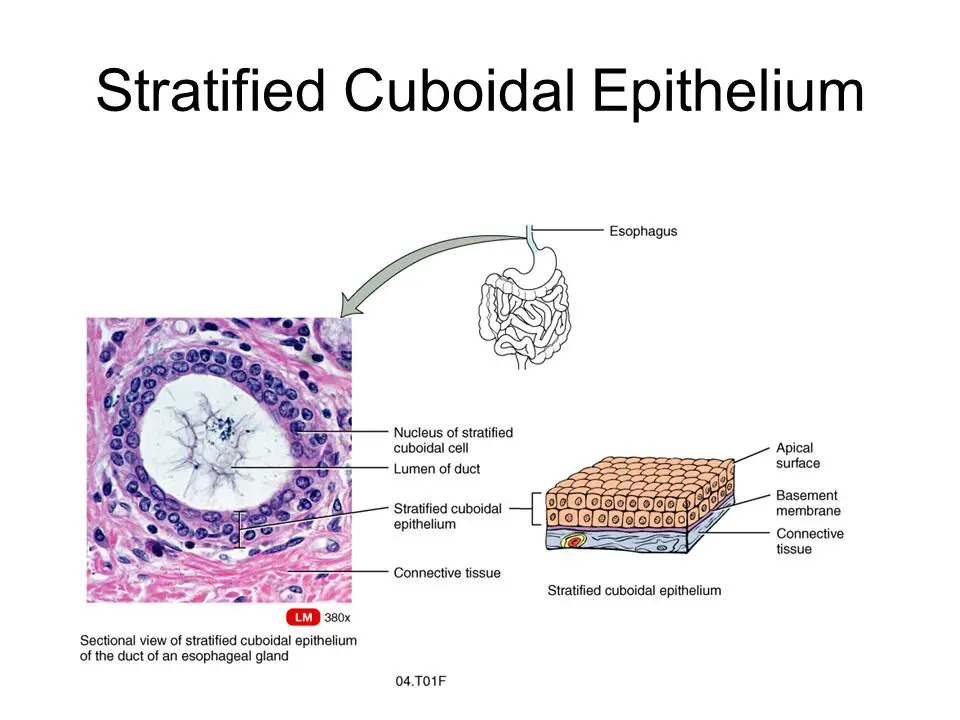
Stratified cuboidal epithelium structure
- The stratified cuboidal epithelium is a specialized tissue characterized by its multi-layered cellular arrangement. The most distinctive feature of this epithelium is the cuboidal shape of the cells in its outermost layer. These cells are meticulously organized, ensuring a compact and gap-free structure.
- Beneath the surface, the deeper layers of the epithelium may comprise cells that are either cuboidal or columnar in morphology. These layers play a pivotal role in maintaining the tissue’s structural integrity. The basal layer, which is the innermost layer, firmly adheres to the basement membrane. In contrast, the succeeding layers are interconnected, ensuring cohesion and stability of the tissue.
- Cellular cohesion within the epithelium is achieved through intricate cellular junctions. These junctions, which include desmosomes and gap junctions, bind the cells tightly to one another. However, an exception is observed in the apical surface of the outermost layer. This layer, devoid of such junctions, faces the lumen of the organ, exposing the cells to the internal environment.
- Cellular turnover is a hallmark of the stratified cuboidal epithelium. As cells in the basal layer undergo division, new cellular layers are formed above. These newly formed cells often undergo modifications, adapting to the specific functions required by the epithelium in that particular region. Over time, cells at the apical layer lose their junctional connections, leading to their eventual shedding. This process, however, is counterbalanced by the continuous emergence of new cells from the basal layer, ensuring a constant renewal of the epithelial surface.
- One notable characteristic of the stratified cuboidal epithelium is its avascularity. This means that the tissue lacks a direct blood supply. Instead, essential nutrients, water, and oxygen are supplied to the epithelium through the process of diffusion. Despite its avascularity, the epithelium is innervated, possessing its own network of nerve fibers.
- In summary, the stratified cuboidal epithelium is a complex and dynamic tissue, marked by its layered cellular structure, cohesive cellular junctions, and continuous cellular turnover. Its avascularity and innervation further underscore its unique physiological attributes in the realm of epithelial tissues.
Stratified cuboidal epithelium function
The stratified cuboidal epithelium, though restricted to specific organs, plays pivotal roles tailored to the needs of these organs.
- Protection: Foremost among its functions is protection. The multi-layered nature of this epithelium fortifies underlying tissues and internal organs against potential physical harm and microbial threats. The presence of gap junctions and desmosomes in the cells forms a robust barrier, thwarting the intrusion of foreign entities. This epithelium not only acts as a shield but also discerningly filters, permitting the ingress of essential nutrients and water while excluding undesired particles. The continuous cellular turnover and repair mechanism further bolster its role as a primary defensive barrier.
- Absorption and Secretion: Beyond protection, the stratified cuboidal epithelium is instrumental in specific absorption and secretion activities. For instance, when lining the ducts of certain glands, it secretes fluids and other substances into the duct. Concurrently, in structures like the urethra, this epithelium is involved in the absorption of water and select ions from urine. In essence, the stratified cuboidal epithelium, while protective in nature, also facilitates regulated exchange processes vital for organ functionality.
Stratified cuboidal epithelium location and stratified cuboidal epithelium examples
Sweat Glands
- Sweat glands, as depicted in the provided image, are integral components of the human integumentary system. A notable feature of these glands is the presence of stratified cuboidal epithelium, as indicated by the black arrow. This epithelium comprises a congregation of cube-shaped cells that encircle a discernible void or empty space. This void represents a minute vessel that extends to the skin’s surface.
- The primary function of sweat glands is thermoregulation. When the body experiences elevated temperatures, the stratified cuboidal epithelium facilitates the passage of salt ions and water into the aforementioned vessel. Upon reaching the skin’s surface and encountering air, this fluid evaporates. This evaporation process plays a crucial role in dissipating heat, resulting in a marked cooling effect on the skin. Through this mechanism, sweat glands contribute significantly to maintaining the body’s optimal temperature.
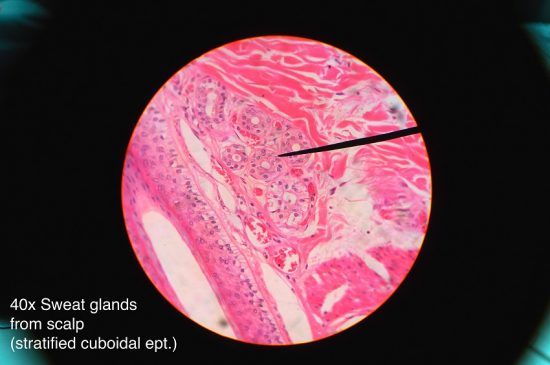
Parotid Glands
- The parotid gland, akin to the sweat gland, plays a pivotal role in the production and secretion of a vital bodily fluid. Specifically, the parotid gland is entrusted with the synthesis and release of saliva into the oral cavity. This salivary secretion is instrumental in facilitating mastication and initiating the digestive process.
- A microscopic examination of parotid tissue, as depicted in the provided image, reveals distinct cellular structures. Notably, the lighter-hued cells on the image’s left side are indicative of the stratified cuboidal epithelium. This epithelium showcases a clear stratification, with numerous squamous cells densely layered behind the cuboidal cells proximate to the salivary ducts.
- In contrast, the darker cells present in the image are presumably involved in the synthesis of various salivary components. These encompass lubricating agents and enzymes, the latter being crucial for commencing the breakdown of ingested food in a timely manner. In essence, the parotid gland’s intricate cellular architecture underscores its significance in oral health and the broader digestive system.
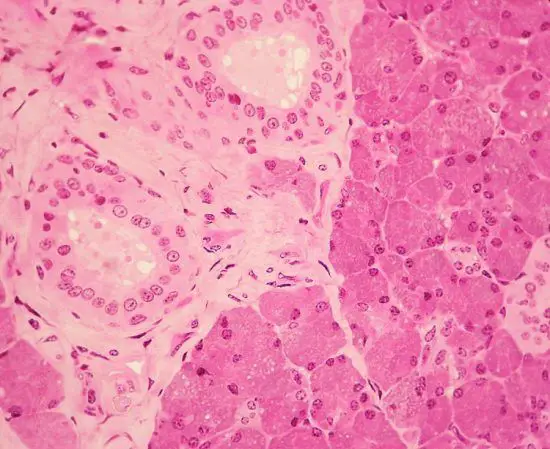
Mammary Glands
- The mammary gland, as visualized in the provided microscopic image, is a complex structure integral to lactation. Even at a relatively broader magnification, the presence of cuboidal cells encircling the ducts is discernible. These cells form a pronounced dark ring around each duct, distinguishing them from the interspersed flatter squamous cells.
- The multitude of ducts evident in the image likely represents a convergence point. These ducts traverse the entirety of the breast, culminating at the nipple. Their primary function is to transport milk, ensuring its efficient delivery to nursing offspring. The stratified cuboidal epithelium plays a dual role in this context. Firstly, it facilitates the secretion of milk.
- Concurrently, it acts as a protective barrier, safeguarding the breast tissues from potential bacterial infiltration and the intrusion of harmful toxins. In essence, the mammary gland’s intricate cellular composition and architecture underscore its pivotal role in reproductive health and offspring sustenance.
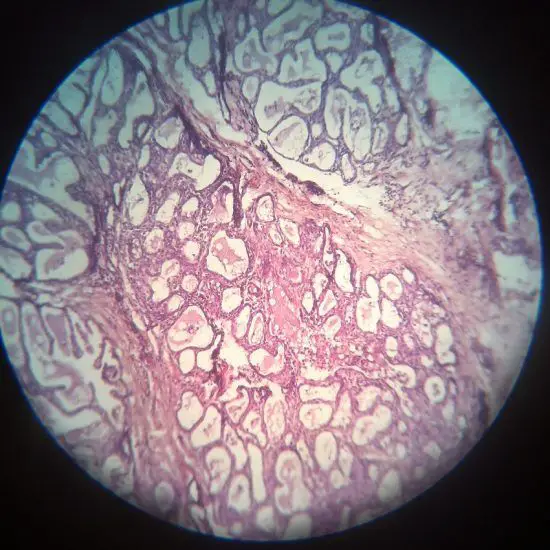
Stratified cuboidal epithelium under microscope
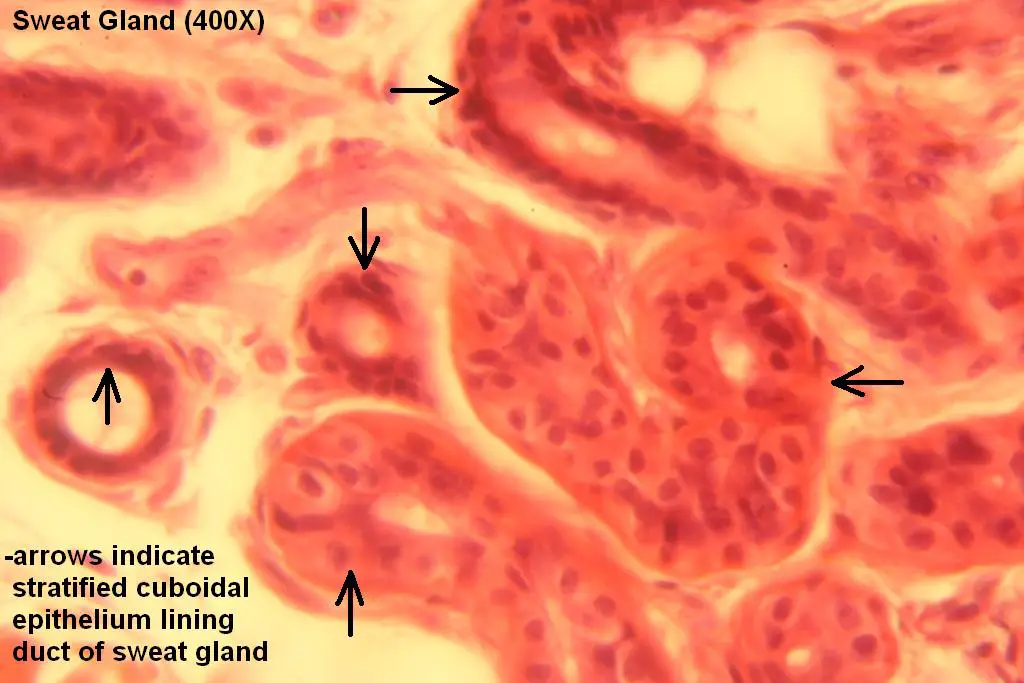
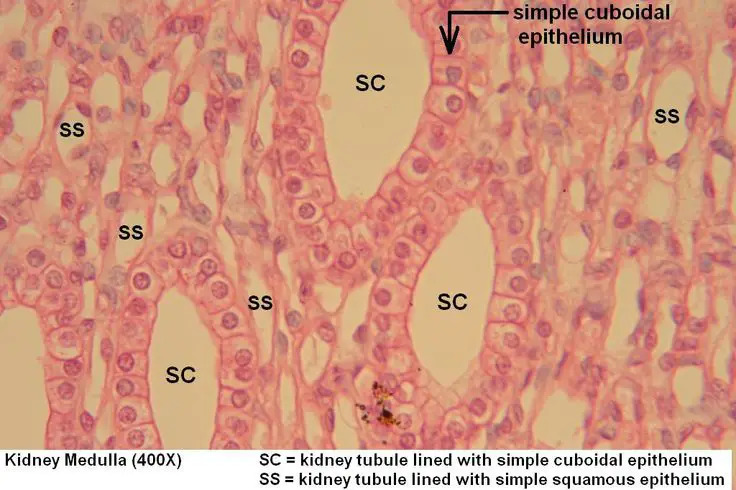

Quiz
Which of the following best describes the stratified cuboidal epithelium?
a) Single layer of cube-shaped cells
b) Multiple layers of columnar cells
c) Single layer of flat cells
d) Multiple layers with cube-shaped cells on the surface
Where is stratified cuboidal epithelium primarily found?
a) Blood vessels
b) Glandular structures
c) Lung alveoli
d) Intestinal lining
What is the primary function of stratified cuboidal epithelium?
a) Gas exchange
b) Absorption of nutrients
c) Protection and secretion
d) Muscle contraction
Which type of junctions are commonly found in stratified cuboidal epithelium?
a) Gap junctions
b) Adherens junctions
c) Hemidesmosomes
d) Tight junctions
The basal layer of stratified cuboidal epithelium is attached to what structure?
a) Basement membrane
b) Connective tissue
c) Muscle tissue
d) Adipose tissue
Which of the following is NOT a function of stratified cuboidal epithelium?
a) Thermoregulation
b) Secretion
c) Protection
d) Absorption
How do the cells in the deeper layers of stratified cuboidal epithelium differ from the surface layer?
a) They are always columnar
b) They are always cuboidal
c) They can be either cuboidal or columnar
d) They are always squamous
Which epithelial tissue has multiple layers with cube-shaped cells at the surface?
a) Simple cuboidal
b) Simple columnar
c) Stratified squamous
d) Stratified cuboidal
Stratified cuboidal epithelium is avascular, meaning it:
a) Has its own nerve supply
b) Contains blood vessels
c) Does not have a direct blood supply
d) Is sensitive to touch
Which of the following organs does NOT contain stratified cuboidal epithelium?
a) Sweat glands
b) Salivary glands
c) Kidneys
d) Ovaries
FAQ
What is stratified cuboidal epithelium?
Stratified cuboidal epithelium is a type of epithelial tissue characterized by multiple layers of cells, with the surface layer consisting of cube-shaped cells.
Where is stratified cuboidal epithelium commonly found?
This epithelium is primarily found in glandular structures, such as sweat, salivary, and mammary glands.
What is the primary function of stratified cuboidal epithelium?
Its main functions include protection, secretion, and, in some cases, limited absorption.
How does stratified cuboidal epithelium differ from simple cuboidal epithelium?
While both have cube-shaped cells on the surface, stratified cuboidal epithelium has multiple layers of cells, whereas simple cuboidal epithelium consists of a single layer.
Why is the stratified cuboidal epithelium considered avascular?
It is termed avascular because it does not have its own direct blood supply. Instead, it receives nutrients through diffusion from nearby tissues.
How does the stratified cuboidal epithelium protect underlying tissues?
The multiple layers of cells, along with tight junctions like gap junctions and desmosomes, create a barrier that prevents the entry of foreign particles and microbes.
Do all layers of the stratified cuboidal epithelium contain cube-shaped cells?
No, while the surface layer consists of cube-shaped cells, the deeper layers can be either cuboidal or columnar in shape.
How does the stratified cuboidal epithelium contribute to secretion?
In glandular structures, this epithelium aids in the secretion of substances like sweat, saliva, or milk by facilitating the passage of these fluids into ducts.
What role do the squamous cells play in stratified cuboidal epithelium?
Squamous cells, which are flatter, are often found in the deeper layers and play a role in supporting and protecting the cuboidal cells on the surface.
Can stratified cuboidal epithelium regenerate and repair itself?
Yes, the cells in the basal layer continuously divide and form new layers, ensuring that damaged or dead cells on the surface are regularly replaced.
References
- Biology Dictionary. (n.d.). Stratified cuboidal epithelium. Retrieved from https://biologydictionary.net/stratified-cuboidal-epithelium/
- Microbe Notes. (n.d.). Stratified cuboidal epithelium. Retrieved from https://microbenotes.com/stratified-cuboidal-epithelium/
- Lumen Learning. (n.d.). Epithelial tissue. Retrieved from https://courses.lumenlearning.com/suny-ap1/chapter/epithelial-tissue/
- Wikipedia. (n.d.). Stratified cuboidal epithelium. Retrieved from https://en.wikipedia.org/wiki/Stratified_cuboidal_epithelium
- Biology Online. (n.d.). Stratified cuboidal epithelium. Retrieved from https://www.biologyonline.com/dictionary/stratified-cuboidal-epithelium
- Kenhub. (n.d.). Stratified epithelium. Retrieved from https://www.kenhub.com/en/library/anatomy/stratified-epithelium
- Histology Guide. (n.d.). MH-109 esophagus. Retrieved from https://histologyguide.com/slideview/MH-109-esophagus/02-slide-2.html
